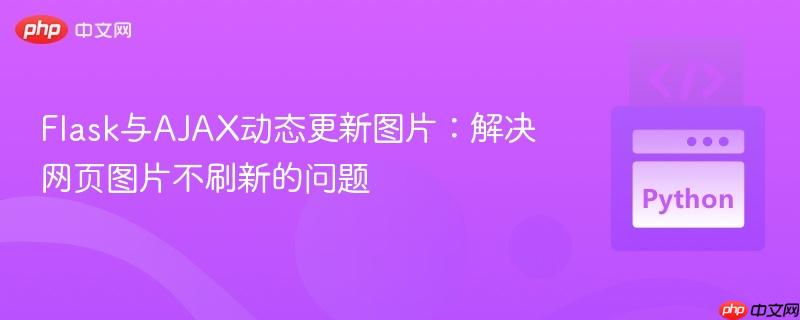
在现代web应用中,动态更新页面内容,尤其是图片,是提升用户体验的关键一环。flask作为轻量级python web框架,结合ajax(asynchronous javascript and xml)技术,可以实现无页面刷新的内容更新。然而,在实践中,开发者可能会遇到ajax请求成功但图片在网页上不更新的问题。本文将深入探讨这一问题的原因,并提供一个专业且可靠的解决方案。
原始代码的目标是通过点击按钮,每隔一段时间从服务器获取一张随机图片并更新到网页上。前端使用jQuery的AJAX方法向Flask后端发送请求,后端接收请求后选择一张新图片。问题出在后端路由update_image的处理方式以及前端对返回数据的预期不符。
后端返回了完整的HTML模板,而非图片URL: 原始的@app.route('/update_image')路由函数返回的是render_template('index.html', current_images = current_images)。这意味着每次AJAX请求都会导致服务器重新渲染整个index.html页面,并将其作为AJAX响应返回给前端。
前端期望的是图片URL字符串: 前端的success回调函数$("#image-display").attr("src", data.current_images);期望data.current_images是一个可以直接赋值给<img>标签src属性的图片URL字符串。然而,当后端返回整个HTML页面时,data变量将是这个HTML字符串,它没有current_images这个属性,因此前端尝试访问data.current_images会失败,或者即使不失败,也无法从中提取出有效的图片URL。
静态文件URL生成不正确: 原始的update_image路由中,虽然current_images = random.choice(image_list)得到了图片文件名,但在返回时直接将其作为current_images传递给render_template。如果目标是返回图片URL供前端使用,那么这个字符串需要通过url_for('static', filename=...)来转换为浏览器可访问的静态文件URL。在原始的index()路由中正确使用了url_for('static', filename=current_images),但在update_image()中缺少了这一步,导致即使前端能解析出current_images,它也只是一个相对路径字符串,而不是一个完整的静态资源URL。
解决这个问题的核心在于让Flask后端在处理AJAX请求时,只返回前端需要的数据(即新的图片URL),并且以前端容易解析的格式(如JSON)返回。同时,确保返回的图片URL是经过url_for('static', filename=...)正确生成的。
我们需要修改update_image路由,使其不再渲染整个HTML页面,而是返回一个包含新图片URL的JSON响应。
import random
from flask import Flask, render_template, jsonify, url_for
app = Flask(__name__)
# 确保图片路径与Flask的static文件夹结构匹配
# 如果图片在 'static/img model/' 目录下,那么filename应是 'img model/Talk1Eh.png'
# Flask默认会查找项目根目录下的 'static' 文件夹
image_list = [
'img model/Talk1Eh.png',
'img model/Talk1Mmm.png',
'img model/Talk1OpenMouth_Oh.png',
'img model/Talk1OpenMouthA.png',
'img model/Talk1OpenMouthHA.png'
]
@app.route('/')
def index():
# 首次加载页面时,渲染模板并传递一个初始图片URL
initial_image = random.choice(image_list)
return render_template('index.html', current_images=url_for('static', filename=initial_image))
@app.route('/update_image')
def update_image():
# AJAX请求时,只返回新的图片URL,不渲染整个模板
new_image_filename = random.choice(image_list)
print(f"Serving new image: {new_image_filename}") # 用于调试
# 使用 url_for('static', filename=...) 生成正确的静态文件URL
new_image_url = url_for('static', filename=new_image_filename)
# 使用 jsonify 返回JSON格式的数据
return jsonify(current_images=new_image_url)
if __name__ == '__main__':
app.run(debug=True)
重要提示: 确保你的图片文件(例如Talk1Eh.png)是放置在Flask应用根目录下的static/img model/路径中。例如,如果你的app.py在项目根目录,那么图片应该在your_project/static/img model/。
前端的JavaScript代码在接收到JSON响应后,能够正确地解析并更新图片src属性。原始的jQuery AJAX success回调函数$("#image-display").attr("src", data.current_images);在这种情况下是完全正确的,因为它会从返回的JSON对象中提取current_images键的值(即新的图片URL)。
<!DOCTYPE html>
<html lang="en">
<head>
<meta charset="UTF-8">
<meta name="viewport" content="width=device-width, initial-scale=1.0">
<title>Image Viewer</title>
<script src="https://code.jquery.com/jquery-3.6.4.min.js"></script>
</head>
<body>
<h1>Image Viewer</h1>
<!-- 初始图片URL由Flask在渲染时提供 -->
<img id="image-display" src="{{ url_for('static', filename=current_images) }}" alt="Random Image">
<br>
<button id="update-button">Update Image</button>
<div id="countdown">5</div>
<script>
// Function to update the image using Ajax
function updateImage() {
$.ajax({
url: "{{ url_for('update_image') }}", // 调用Flask的AJAX更新路由
method: "GET",
dataType: "json", // 明确指定期望的响应数据类型为JSON
success: function(data) {
// 接收到JSON数据,其中包含 current_images 键
if (data && data.current_images) {
$("#image-display").attr("src", data.current_images);
console.log("Image updated to: " + data.current_images); // 调试输出
} else {
console.error("AJAX response did not contain 'current_images'.", data);
}
},
error: function(xhr, status, error) {
console.error("AJAX error:", status, error);
}
});
}
// Function to handle the button click
function handleButtonClick() {
var countdown = 5;
$("#countdown").text(countdown); // 初始显示倒计时
// 立即更新一次图片,并启动定时器
updateImage();
// Update the countdown and the image every 0.2 seconds
var countdownInterval = setInterval(function() {
countdown--; // 先递减,再判断
$("#countdown").text(countdown);
if (countdown <= 0) { // 当倒计时归零或更小时
clearInterval(countdownInterval);
$("#countdown").text(""); // 清空倒计时显示
} else {
updateImage(); // 每次倒计时更新时获取新图片
}
}, 200); // 200毫秒 = 0.2秒
}
// Attach click event to the button
$("#update-button").click(function() {
handleButtonClick();
});
</script>
</body>
</html>
为了方便理解,这里提供完整的app.py和index.html代码,它们包含了上述所有修改。
app.py
import random
from flask import Flask, render_template, jsonify, url_for
app = Flask(__name__)
# 假设图片文件位于 'static/img model/' 目录下
image_list = [
'img model/Talk1Eh.png',
'img model/Talk1Mmm.png',
'img model/Talk1OpenMouth_Oh.png',
'img model/Talk1OpenMouthA.png',
'img model/Talk1OpenMouthHA.png'
]
@app.route('/')
def index():
# 首次加载页面时,渲染模板并传递一个初始图片URL
initial_image = random.choice(image_list)
return render_template('index.html', current_images=initial_image) # 这里传递的是文件名,模板内部会用url_for处理
@app.route('/update_image')
def update_image():
# AJAX请求时,只返回新的图片URL,不渲染整个模板
new_image_filename = random.choice(image_list)
print(f"Serving new image: {new_image_filename}") # 用于调试
# 使用 url_for('static', filename=...) 生成正确的静态文件URL
new_image_url = url_for('static', filename=new_image_filename)
# 使用 jsonify 返回JSON格式的数据
return jsonify(current_images=new_image_url)
if __name__ == '__main__':
app.run(debug=True)
index.html
<!DOCTYPE html>
<html lang="en">
<head>
<meta charset="UTF-8">
<meta name="viewport" content="width=device-width, initial-scale=1.0">
<title>Image Viewer</title>
<script src="https://code.jquery.com/jquery-3.6.4.min.js"></script>
</head>
<body>
<h1>Image Viewer</h1>
<!-- 初始图片URL由Flask在渲染时提供 -->
<!-- 注意:这里 {{ url_for('static', filename=current_images) }} 是在首次渲染时将文件名转换为URL -->
<img id="image-display" src="{{ url_for('static', filename=current_images) }}" alt="Random Image">
<br>
<button id="update-button">Update Image</button>
<div id="countdown">5</div>
<script>
// Function to update the image using Ajax
function updateImage() {
$.ajax({
url: "{{ url_for('update_image') }}", // 调用Flask的AJAX更新路由
method: "GET",
dataType: "json", // 明确指定期望的响应数据类型为JSON
success: function(data) {
// 接收到JSON数据,其中包含 current_images 键
if (data && data.current_images) {
$("#image-display").attr("src", data.current_images);
console.log("Image updated to: " + data.current_images); // 调试输出
} else {
console.error("AJAX response did not contain 'current_images'.", data);
}
},
error: function(xhr, status, error) {
console.error("AJAX error:", status, error);
}
});
}
// Function to handle the button click
function handleButtonClick() {
var countdown = 5;
$("#countdown").text(countdown); // 初始显示倒计时
// 立即更新一次图片,并启动定时器
updateImage();
// Update the countdown and the image every 0.2 seconds
var countdownInterval = setInterval(function() {
countdown--; // 先递减,再判断
$("#countdown").text(countdown);
if (countdown <= 0) { // 当倒计时归零或更小时
clearInterval(countdownInterval);
$("#countdown").text(""); // 清空倒计时显示
} else {
updateImage(); // 每次倒计时更新时获取新图片
}
}, 200); // 200毫秒 = 0.2秒
}
// Attach click event to the button
$("#update-button").click(function() {
handleButtonClick();
});
</script>
</body>
</html>
通过将Flask后端update_image路由修改为返回包含正确静态文件URL的JSON响应,并确保前端AJAX请求正确处理此JSON数据,我们成功解决了图片不刷新的问题。这种前后端分离、通过JSON进行数据交换的模式是构建现代Web应用的标准做法,它使得应用更具响应性、可维护性,并提供了更好的用户体验。
以上就是Flask与AJAX动态更新图片:解决网页图片不刷新的问题的详细内容,更多请关注php中文网其它相关文章!

每个人都需要一台速度更快、更稳定的 PC。随着时间的推移,垃圾文件、旧注册表数据和不必要的后台进程会占用资源并降低性能。幸运的是,许多工具可以让 Windows 保持平稳运行。




Copyright 2014-2025 https://www.php.cn/ All Rights Reserved | php.cn | 湘ICP备2023035733号